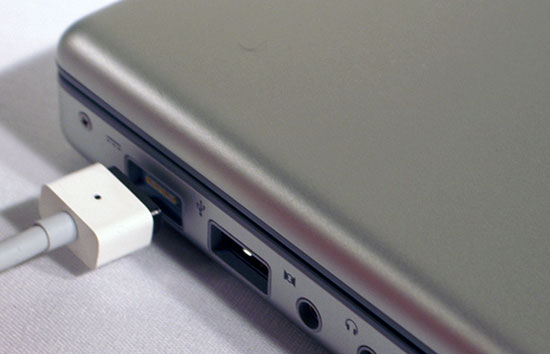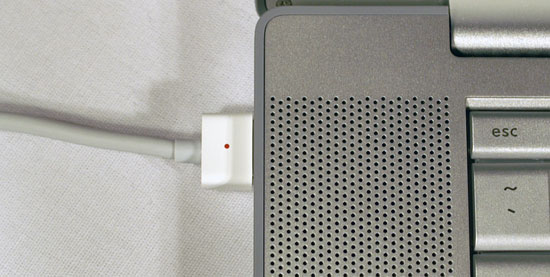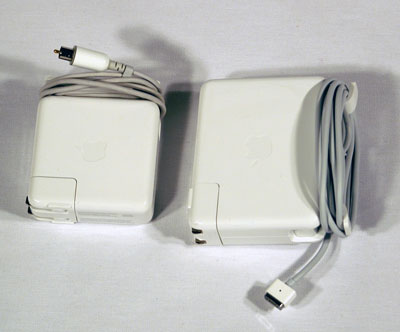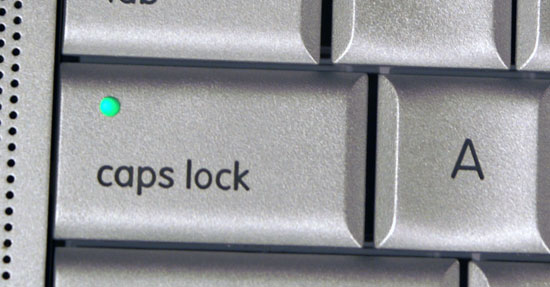Apple's MacBook Pro: Using it as a Mac and a PC
by Anand Lal Shimpi on April 13, 2006 12:00 AM EST- Posted in
- Mac
With the MacBook Pro Apple introduced its MagSafe power connector, a magnetic power connector that's designed to easily break away if you accidentally step on the cord or pull it too far instead of taking the notebook down with it. The idea makes a lot of sense, and the connector is significantly smaller than its predecessor, but there are many cases where it can get annoying. Although the MagSafe connector remains attached most of the time, the minute you put more strain than normal on the power cable you can expect it to break away. While normally this behavior would be what you want, it's generally not what you expect if you're used to conventional power connectors. I'm convinced that the MagSafe approach is safer as the chances of you breaking your power connector or even worse, your laptop, are far diminished but it takes some getting used to. If you're used to using your notebook at the very limits of its power cable's length, you'll have to change your ways as the MagSafe connector won't allow it.

MagSafe


The PowerBook G4's old power connector

PowerBook G4 power adapter (left) vs. MacBook Pro adapter (right)
The caps lock LED is now a much brighter green compared to its predecessor's yellow-green color. The MagSafe power connector also features the same green LED, and when charging the LED turns a similarly bright orange. The size of the light on the power connector has been reduced, though, which means that the MacBook Pro won't illuminate a dark hotel room nearly as much as the old PowerBooks did when charging while you sleep. Having spent many trips covering my PowerBook with a pillow while it charged, the change is welcome.

The MacBook Pro's keyboard is identical to its predecessors, which overall isn't a bad thing. The PowerBook G4's keyboard ended up being one of my all time favorites, second only to ThinkPad keyboards which continue to be my top choice for anyone who writes a lot. Being that it uses the same keyboard as before, the MacBook Pro doesn't feature any dedicated page up/page down keys nor any dedicated home/end keys (they are shared with the arrow keys). I would assume that a solid portion of Apple's customers may be folks who happen to be writers, in which case it would make sense for Apple to invest in an updated keyboard layout that accommodates keys frequently used by them.
My only other complaint about the keyboard is actually a complaint I have about virtually all notebook keyboards - that the fn key does not need to be in the lower left corner of the notebook. There are less frequently used areas on the keyboard to stick that key and for some reason it always ends up being around the keys I use fairly frequently (left ctrl, left option and left command). This isn't really any Apple-specific complaint, but rather something that has bothered me about every notebook keyboard I've used.
The trackpad on the MacBook Pro is huge; it's one of the first things I noticed after lifting the display lid. Other than the "why-not?" factor, it seems that Apple made it so big to better accommodate the scrolling functionality that's supported by it. Using two fingers on the trackpad you can now scroll horizontally or vertically. The process is actually extremely natural and far better than other systems I've used where only particular parts of the trackpad are reserved for scrolling. Just as you would guess, you place two fingers on the trackpad and move them in the direction you wish to scroll. Your cursor disappears and you begin to scroll; while it's not as natural as using a scroll wheel on a mouse, it's pretty darn close.

The MacBook Pro, like the Intel based iMac Core Duo, features an integrated iSight camera and Front Row support, both of which I've already looked at. The implementation is no different on the MacBook Pro, and the integrated iSight camera is arguably even more useful on a notebook where you're less likely to have an external USB camera just laying around.










52 Comments
View All Comments
mzlin - Saturday, April 15, 2006 - link
Excellent review, Anand! The Parallels vs Boot Camp comparisons are really well done and very helpful.I thought the comment about PowerBook weight being 1/3 more than any other laptop you've used was a little misleading. I'm sure you didn't mean to say the PowerBook was especially heavy, but since you didn't actually mention what it weighs (5.6 pounds), it could be construed as the Powerbook weighs 1/3 more than other 15.4-inch laptops.
I have been looking for 15.4-inch laptops, PC or Mac, that weigh less than 6 pounds with an integrated optical drive. (For me, having the drive integrated is non-negotiable; I wouldn't want to have it in the wrong place when I needed it, so I would be carrying it around regardless, and much better to save the hassle of digging it out and plugging it in when one needs it.) But the Powerbook/MacBook is the only one I have found so far. On the PC side, the VAIO BX and Toshiba Satellite A105 manage to get to 6.0 pounds, but are also are 1.5 inches thick.
hechacker1 - Saturday, April 15, 2006 - link
I'd just like to point out that the buzzing due to power state switching (transitioning between C3 and C4 states) also happens in windows and linux. It's purely a hardware issue, and in most cases it just means the manufacturer used low quality components (capacitors).In windows it is not as noticible because it runs with a kernel frequency of 100Hz. In linux it's often run with 1000Hz. Because of the increase in frequency of power state switching the buzzing becomes audible to the ear.
In windows it happens 10 times less than most linux boxes. Hence you don't hear it as much even with low quality components. My own Dell 700m laptop has this issue.
The only solution in linux is to disable the lower power states, or change the kernel timer to 100Hz like windows. The best solution is to use dynamic tick switching so you get exactly the responsiveness you need, only when you need it. With a patched linux kernel my laptop automatically goes to 54Hz when idle, and 1000Hz when under load.
Anyways... the only reason those "fixes" work is probably because they cause the processor to do just enough work to avoid having to go into the lowest power mode.
corequadro - Friday, April 14, 2006 - link
I found it as a perfect help against the annoying whine. Just start and then stopp it, and you will – if you aren't using ichat – have a perfectly silent macbook till the next reboot.Of course, a fix from Apple would be more effective, but I can live with the widget fix.
brich - Friday, April 14, 2006 - link
I really think the MacBooks have legs to grow, especially once the intel transition is completed over the next year and universal support becomes more 'universal.' My 12" PowerBook G4 1.5 has served me very well, even with the limitations of XP Pro running in VPC 7 inside Tiger. I think that some of the PC-only enthusiasts who add a MacBook to their arsenal will discover that the integration of excellent hardware esthetic and design with an OS that is continually developing/improving (OSX) will make the Mac solution quite compelling.That said, if I were a user who was totally satisfied with Windows and was not interested in OSX, then I would not buy a Mac to run Windows...no reason to do it. The real differentiation is the new flexibility of the intel Macs with OSX as a viable alternative to XP now and Vista later. Ther ability to run XP on them is frosting on the cake, imho.
ohnnyj - Friday, April 14, 2006 - link
Dear Apple,I want a 12in Merom MacBook.
Desslok - Thursday, April 13, 2006 - link
Acorrding to Daily Tech the hardware bugs you talked about are fixed with the new revs of the MacBook Pro. The article also stated that Apple would allow you to trade your MacBook in if you were having these problems.JAS - Thursday, April 13, 2006 - link
Tonight, I visited an Apple Store to see the MacBook Pro in person. What a gorgeous, well engineered laptop -- and impressively fast! The units on display did have rather warm undersides; but perhaps these are from the initial manufacturing run ("version A").trooper11 - Thursday, April 13, 2006 - link
Great job on the review, it was interesting to see how close things are coming on the software side to run a Windows environment on Macs and pointing out how similar Macs have gotten to every other laptop maker, at least in terms of parts and performance.The thing that gets me now is that the change over to Intel processors and ,in general, a more universal system, has made the Mac just another notebook vendor. So whst the Mac Book Pro has going for it is OS X and any of the Apple software, the machine itself is no better or worse then the many laptop manufacturers putting out Windows based pcs. In the past Macs had sort of mystique relating toa percieved uniqueness.
If everyone realizes this, then Id like to see a review of a Mac Book from the perspective of any normal system evaluation. Comparing the experience with Apple with those of HP, Dell, Acer, or even Lenovo. If Im not a fan of the Mac OS, then I dont see any other reason to pick them over say Acer or Lenovo. I certainly wouldnt pay a price premium for the Apple name unless I saw some first hand reviews relating to price/performance and quality of service you can expect.
anthlover - Thursday, April 13, 2006 - link
Those who have a powerbook that runds under 1ghz will be well served by the new books NOW. Those that have 1.5 and 1.67 have not need to quickly switch unless there is some native apps including apps free ones they want to use.Those that have no book will do well with them.
Waiting unless somthing new was coming out in a couple of weeks is silly. Computers and their prices change constantly, models are refreshed and replaced rapidly. One should always buy what they need and try to future proof too much.
Of course those wanting to save might want to wait for the Ibooks err Mac Book.
Glad to hear replacing the drive got **easier then on the earlier Alumibooks... Or at least the 12 inch one. I got through the keyboard replacement part of the disasemly I had done before and then read ahead to the upper case disassembly and realized that I need a brighter room, no cats trying to help, and a lot of care. Too much risk. With the books It sounds like when you want that 200gb 7200 rpm drive it will be easy to put in:)
plinden - Thursday, April 13, 2006 - link
The choppiness can be made almost unnoticeable by reducing the "Hardware acceleration" - Display Properties/Settings/Advanced/Troubleshooting, and move the slider one notch to the left.